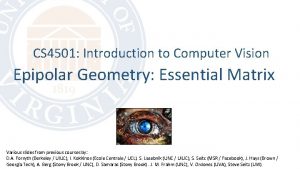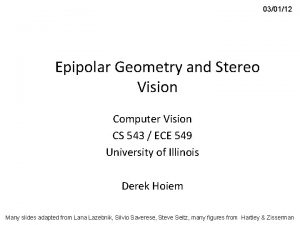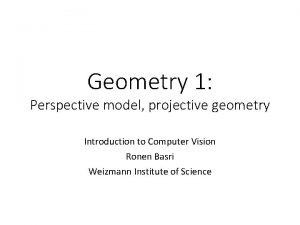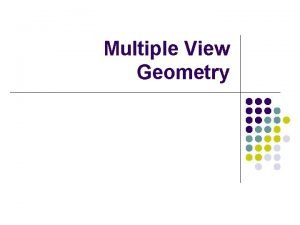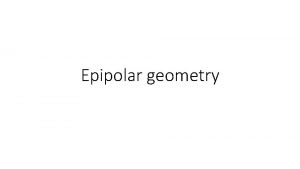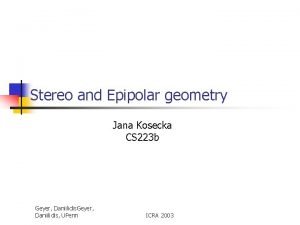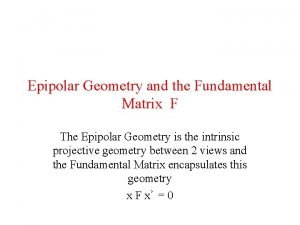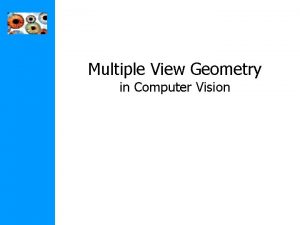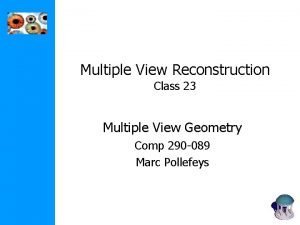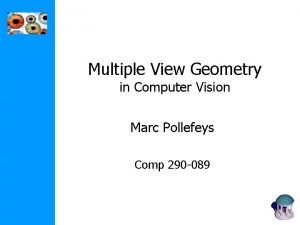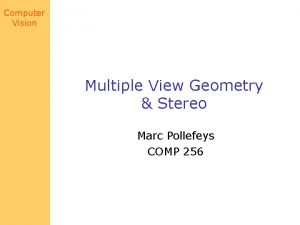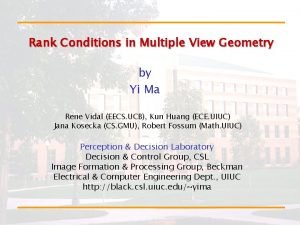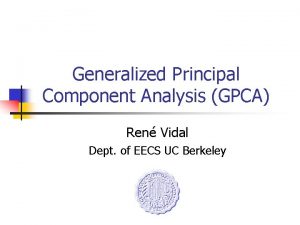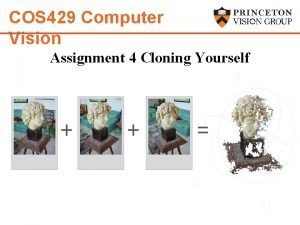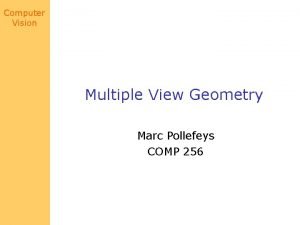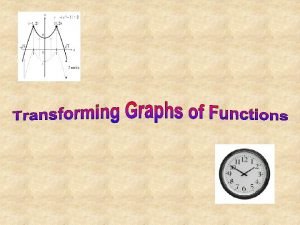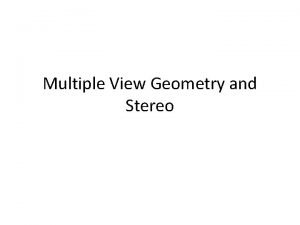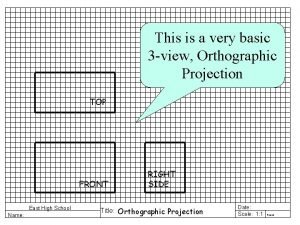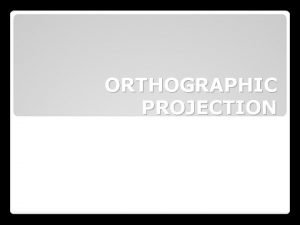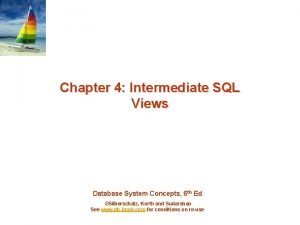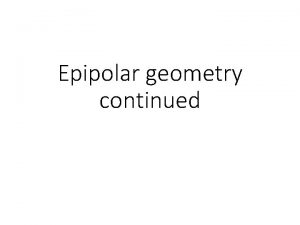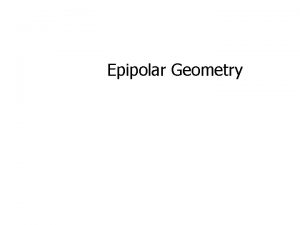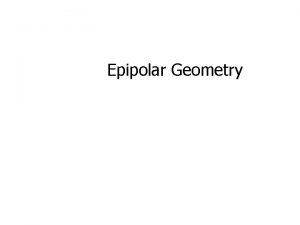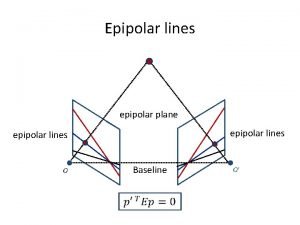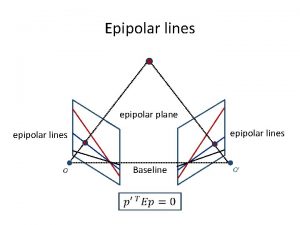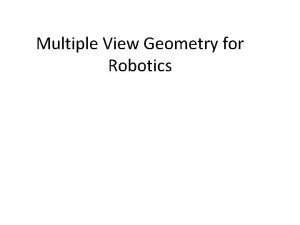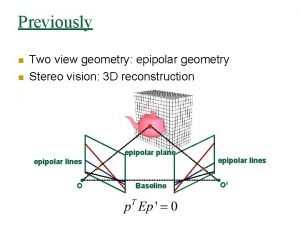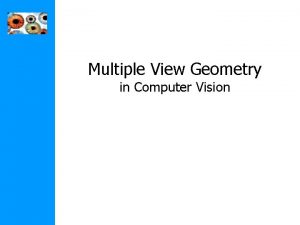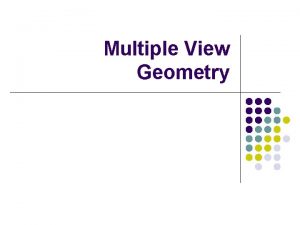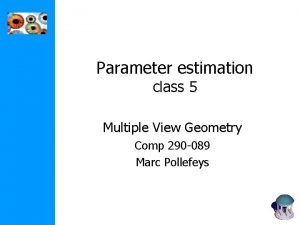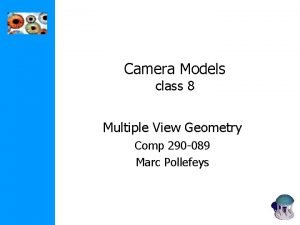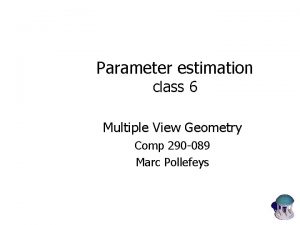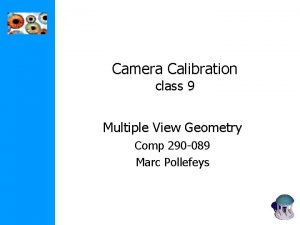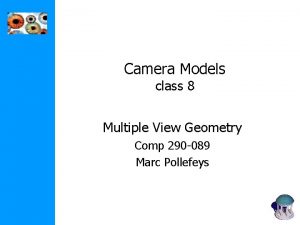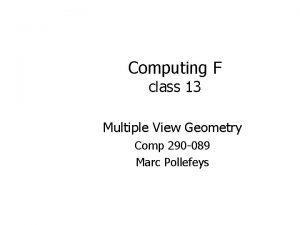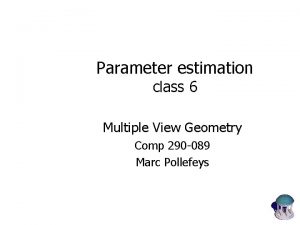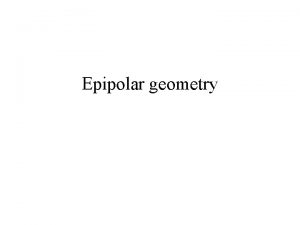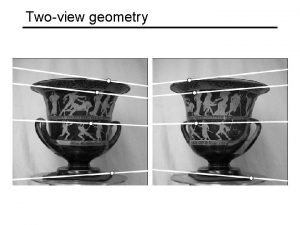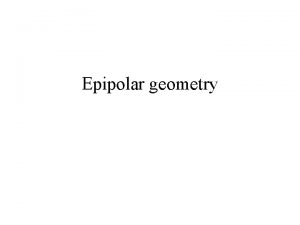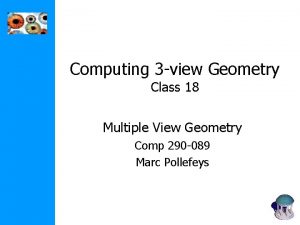Epipolar Geometry class 11 Multiple View Geometry Comp



















![The epipolar line geometry l, l’ epipolar lines, k line not through e l’=F[k]xl The epipolar line geometry l, l’ epipolar lines, k line not through e l’=F[k]xl](https://slidetodoc.com/presentation_image_h2/81d313c5ee5e10c8925355c6f5f6b8d8/image-20.jpg)




![Geometric representation of F Fs: Steiner conic, 5 d. o. f. Fa=[xa]x: pole of Geometric representation of F Fs: Steiner conic, 5 d. o. f. Fa=[xa]x: pole of](https://slidetodoc.com/presentation_image_h2/81d313c5ee5e10c8925355c6f5f6b8d8/image-25.jpg)







- Slides: 32

Epipolar Geometry class 11 Multiple View Geometry Comp 290 -089 Marc Pollefeys

Multiple View Geometry course schedule (subject to change) Jan. 7, 9 Intro & motivation Projective 2 D Geometry Jan. 14, 16 (no class) Projective 2 D Geometry Jan. 21, 23 Projective 3 D Geometry (no class) Jan. 28, 30 Parameter Estimation Feb. 4, 6 Algorithm Evaluation Camera Models Feb. 11, 13 Camera Calibration Single View Geometry Feb. 18, 20 Epipolar Geometry 3 D reconstruction Feb. 25, 27 Fund. Matrix Comp. Structure Comp. Planes & Homographies Trifocal Tensor Three View Reconstruction Multiple View Geometry Mar. 4, 6 Mar. 18, 20 Mar. 25, 27 Multiple. View Reconstruction Bundle adjustment Apr. 1, 3 Auto-Calibration Papers Apr. 8, 10 Dynamic Sf. M Papers Apr. 15, 17 Cheirality Papers Apr. 22, 24 Duality Project Demos

More Single-View Geometry • Projective cameras and planes, lines, conics and quadrics. • Camera calibration and vanishing points, calibrating conic and the IAC

Two-view geometry Epipolar geometry 3 D reconstruction F-matrix comp. Structure comp.

Three questions: (i) Correspondence geometry: Given an image point x in the first view, how does this constrain the position of the corresponding point x’ in the second image? (ii) Camera geometry (motion): Given a set of corresponding image points {xi ↔x’i}, i=1, …, n, what are the cameras P and P’ for the two views? (iii) Scene geometry (structure): Given corresponding image points xi ↔x’i and cameras P, P’, what is the position of (their pre-image) X in space?

The epipolar geometry (a) C, C’, x, x’ and X are coplanar

The epipolar geometry b What if only C, C’, x are known?

The epipolar geometry a All points on p project on l and l’

The epipolar geometry b Family of planes p and lines l and l’ Intersection in e and e’

The epipolar geometry epipoles e, e’ = intersection of baseline with image plane = projection of projection center in other image = vanishing point of camera motion direction an epipolar plane = plane containing baseline (1 -D family) an epipolar line = intersection of epipolar plane with image (always come in corresponding pairs)

Example: converging cameras

Example: motion parallel with image plane


The fundamental matrix F algebraic representation of epipolar geometry we will see that mapping is (singular) correlation (i. e. projective mapping from points to lines) represented by the fundamental matrix F

The fundamental matrix F geometric derivation mapping from 2 -D to 1 -D family (rank 2)

The fundamental matrix F algebraic derivation (note: doesn’t work for C=C’ F=0)

The fundamental matrix F correspondence condition The fundamental matrix satisfies the condition that for any pair of corresponding points x↔x’ in the two images

The fundamental matrix F F is the unique 3 x 3 rank 2 matrix that satisfies x’TFx=0 for all x↔x’ (i) Transpose: if F is fundamental matrix for (P, P’), then FT is fundamental matrix for (P’, P) (ii) Epipolar lines: l’=Fx & l=FTx’ (iii) Epipoles: on all epipolar lines, thus e’TFx=0, x e’TF=0, similarly Fe=0 (iv) F has 7 d. o. f. , i. e. 3 x 3 -1(homogeneous)-1(rank 2) (v) F is a correlation, projective mapping from a point x to a line l’=Fx (not a proper correlation, i. e. not invertible)

Epipolar Line Homography
![The epipolar line geometry l l epipolar lines k line not through e lFkxl The epipolar line geometry l, l’ epipolar lines, k line not through e l’=F[k]xl](https://slidetodoc.com/presentation_image_h2/81d313c5ee5e10c8925355c6f5f6b8d8/image-20.jpg)
The epipolar line geometry l, l’ epipolar lines, k line not through e l’=F[k]xl and symmetrically l=FT[k’]xl’ (pick k=e, since e. Te≠ 0)

Pure Translation camera motion

Fundamental matrix for pure translation Forward motion

Fundamental matrix for pure translation example: motion starts at x and moves towards e, faster depending on Z pure translation: F only 2 d. o. f. , x. T[e]xx=0 auto-epipolar

General motion
![Geometric representation of F Fs Steiner conic 5 d o f Faxax pole of Geometric representation of F Fs: Steiner conic, 5 d. o. f. Fa=[xa]x: pole of](https://slidetodoc.com/presentation_image_h2/81d313c5ee5e10c8925355c6f5f6b8d8/image-25.jpg)
Geometric representation of F Fs: Steiner conic, 5 d. o. f. Fa=[xa]x: pole of line ee’ w. r. t. Fs, 2 d. o. f.

Pure planar motion Steiner conic Fs is degenerate (two lines)

Projective transformation and invariance Derivation based purely on projective concepts F invariant to transformations of projective 3 -space unique not unique canonical form

Projective ambiguity of cameras given F previous slide: at least projective ambiguity this slide: not more! ~~ Show that if F is same for (P, P’) and (P, P’), there exists a projective transformation H so that ~ ~ P=HP and P’=HP’ lemma:

Canonical cameras given F F matrix corresponds to P, P’ iff P’TFP is skew-symmetric Possible choice:

The essential matrix ~fundamental matrix for calibrated cameras (remove K) 5 d. o. f. (3 for R; 2 for t up to scale) E is essential matrix if and only if two singularvalues are equal (and third=0)

Four possible reconstructions from E (only one solution where points is in front of both cameras)

Next class: 3 D reconstruction
 Pixel coordinates
Pixel coordinates Epipolar geometry computer vision
Epipolar geometry computer vision Epipolar geometry computer vision
Epipolar geometry computer vision Epipolar geometry
Epipolar geometry Quadrifocal
Quadrifocal Fundamental matrix song
Fundamental matrix song Geometry
Geometry Essential matrix
Essential matrix Multiple view geometry in computer vision.
Multiple view geometry in computer vision. Multiple view geometry
Multiple view geometry Quadrifocal
Quadrifocal Multi view geometry
Multi view geometry Multiple view geometry
Multiple view geometry Multiple view geometry
Multiple view geometry Multiple view geometry
Multiple view geometry Tensor notation
Tensor notation Baseline
Baseline Example of mimd
Example of mimd Multiple transformations geometry
Multiple transformations geometry Pf3 molecular geometry
Pf3 molecular geometry Electron domain geometry vs molecular geometry
Electron domain geometry vs molecular geometry The basis of the vsepr model of molecular bonding is
The basis of the vsepr model of molecular bonding is Single view geometry
Single view geometry Single view geometry
Single view geometry Top view is directly above the front view
Top view is directly above the front view What line types are usually omitted from sectional views
What line types are usually omitted from sectional views Section
Section Half section view example
Half section view example Birds eye vs worm's eye
Birds eye vs worm's eye End view meaning in drawing
End view meaning in drawing Technical drawing isometric projection
Technical drawing isometric projection For the view create view instructor_info as
For the view create view instructor_info as Simple view and complex view
Simple view and complex view

